Microbiology grad student finds success through ASU community connections

Mark Reynolds
Editor’s note: This story is part of a series of profiles of notable fall 2022 graduates.
Being an ASU student taught Mark Reynolds the importance of making connections with those around you.
“I learned the power of social interactions as a catalyst for advancing research. ASU offers a wealth of expertise and resources that one is surprised to learn overlaps to some degree with their own work and interests,” said Reynolds, who earned his PhD in microbiology from the School of Life Sciences (SOLS) at Arizona State University.
“Interactions with researchers also studying microbiology or engineering was most important for me, but conversing informally at school events and through the number of research centers available to SOLS faculty and their students changed my perspective on how to approach new and continued conversations as a scientist,” says Reynolds, who worked closely with Biodesign Institute faculty such as Hinsby Cadillo-Quiroz and Rosa Krajmalnik-Brown.
In his time at ASU, Reynolds also earned the Robert P. Stearns/SCS Engineers Scholarship from the Solid Waste Association of North America, which allowed him to further pursue his research in microbiology.
Reynolds conducted his research work through the Biodesign Swette Center for Environmental Biotechnology and the Biodesign Center for Health Through Microbiomes. Reynolds characterized and manipulated microbiomes from arid landfills for improved methane production for his thesis research, as he focuses on understanding the interactions of bacteria in their environment.
Following graduation, Reynolds plans on working in industry or governmental scientist positions but has also been considering university-level instruction positions.
Question: What was your “aha” moment, when you realized you wanted to study the field you majored in?
Answer: I became interested in pursuing an advanced degree in microbiology when I was taking an ecological microbiology course at the University of California Merced. It was taught by a former research supervisor, Michael Beman. That’s where I first learned of the role microbes play in the global carbon cycle. I really wanted to work on the complex interactions of different bacteria in the environment and the emerging techniques to study them. When I learned that a different branch of life — archaea — was also intricately interwoven in this cycle and that some can be used in biotechnology through sustainable, biocommodity production, I was convinced I had to be part of this professional goal.
Q: Why did you choose ASU?
A: A short answer is that I chose to pursue my PhD at ASU to explore a new university system and setting. More importantly, I chose ASU because I had positive interactions with several faculty within and outside of SOLS, making me confident my research goals and professional training could be met here.
Q: Which professor taught you the most important lesson while at ASU?
A: I've had several professors that have fortunately taught me valuable lessons or skills at ASU. My dissertation co-chairs, Hinsby Cadillo-Quiroz and Rosa Krajmalnik-Brown, for example, taught me the importance of crafting and communicating research results effectively. The co-heads of my graduate program, Rajeev Misra and Xuan Wang, provided wisdom and support during my training with broad exposure to academic and non-academic opportunities of which I had rarely considered prior to joining ASU.
Q: What’s the best piece of advice you’d give to those still in school?
A: My advice is likely more useful for those in graduate programs conducting research and is not a novel recommendation. Having said that, failure is an important step in your next realization. Whether it's conducting experiments, giving a bad talk, or even performing subpar in a class dropping your undergraduate or graduate GPA, failure is nothing worse than just a sidestep.
Q: What was your favorite spot on campus, whether for studying, meeting friends or just thinking about life?
A: I really enjoyed the landscaping and upkeep nearby Old Main on my daily commute to campus. I also enjoyed the area by the Biodesign Institute, which is especially relaxing around springtime with the blooming palo verde trees!
Q: If someone gave you $40 million to solve one problem on our planet, what would you tackle?
A: I would use the award to most likely promote the adoption of universal health care and equitable living.
Written by Anna Hague
More Science and technology

Cracking the code of online computer science clubs
Experts believe that involvement in college clubs and organizations increases student retention and helps learners build valuable…
Consortium for Science, Policy & Outcomes celebrates 25 years
For Arizona State University's Consortium for Science, Policy & Outcomes (CSPO), recognizing the past is just as important as…

Hacking satellites to fix our oceans and shoot for the stars
By Preesha KumarFrom memory foam mattresses to the camera and GPS navigation on our phones, technology that was developed for…